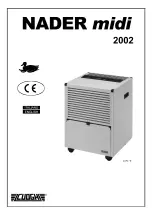
11
Conti Sanitärarmaturen GmbH, Hauptstraße 98, 35435 Wettenberg | Telefon: +49 641 98221 0 | Fax: +49 641 98221 50 | [email protected]
www.conti.plus | gültig ab 01/2018 | Artikelnummer CONDOK0030005 | Druckfehler und Irrtümer sowie technische und maßliche Änderungen vorbehalten
cleaning informations
Surfaces
The most common coating of a sanitary fitting is the
chrome-nickel surface finish according to DIN EN248,
which is also used as surface materials such as stain-
less steel, plastics including powder and wet paint,
anodised aluminium and galvanised surfaces.
Coloured, non-metallic surfaces are generally more
sensitive than metallic surfaces, especially against
scratches. Therefore, it is absolutely essential to
determine the type of surface to be cleaned before
cleaning.
General information on cleaning and care of
sanitary fittings and accessories
In order to meet the market needs in terms of design
and functionality, modern sanitary products today
consist of very different materials and thus place
different demands on the cleaning agents and their
ingredients used.
cleaning agents and tools
Acids are indispensable as a component of cleaning
agents for the removal of lime deposits.
However, in the case of sanitary products, it should be
noted that:
• Only the cleaning agents intended for the area of
application are used.
• Do not use cleaners containing hydrochloric acid,
formic acid or acetic acid, as they can cause consi-
derable damage even after a single application.
• Phosphoric acid cleaning agents are not fully
applicable.
• Do not use detergents containing chlorine bleach.
• The mixing of cleaning agents is generally not
permitted.
• Use of abrasive cleaning agents and equipment,
such as unsuitable scouring agents and pad spon-
ges, may cause damage.
• Preferably cleaning textiles are used which bind as
few particles as possible.
(Woven fabrics are more suitable than woven.)
Tip
Residues of body care products can also cause
damage and must be rinsed off immediately after
using the fittings and accessories with clear, cold
water without leaving any residue. Damage to
surfaces that have already been damaged will
progress as a result of the action of cleaning
agents.
Recommendations for cleaning and care
The instructions for use issued by the cleaning agent
manufacturers must be strictly followed.
Generally, it should be noted that:
• Cleaning must be carried out as required.
• The detergent dosage and duration of action
must be adapted to the object-specific require-
ments and the detergent must never be allowed
to work longer than necessary.
• The build-up of calcification must be prevented by
regular cleaning. Water droplets should therefore
be wiped off with a soft cloth or chamois leather
after use.
• Any limescale deposits must be removed by direct
application of detergent if necessary.
• In the case of spray cleaning, do not spray the
cleaning solution on the sanitary fittings and
accessories, but on the cleaning textile (cloth/
sponge) and thus the cleaning is to be carried
out, as the spray mist can penetrate into openings
and cracks etc. of the fitting and accessories and
cause damage.
• Wash cleaning textiles as often and thoroughly
as possible so that only clean cleaning textiles
without foreign particles are used. Particles depo-
sited in cleaning textiles can lead to scratches and
damage to surfaces.
• After cleaning, rinse thoroughly with clear water
to remove any remaining product buildup.
surface protection
Lacquered and galvanized surfaces should be provided
with a thin protective film on a regular basis. The use
of a preservative specially formulated for lacquered or
galvanised surfaces is recommended. w






























